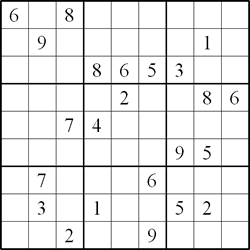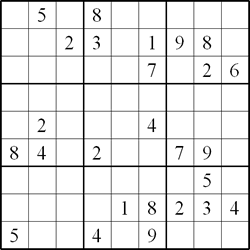Skip over navigation
By Henry Kwok
Here
is a Word document with the two Sudoko grids that you can download
for printing.



 The four puzzles (fig 1 to fig 4) are equivalent to one another.
Equivalent puzzles can also be created from fig 1 and fig 2 by
renaming the elements in the respective grids. Instead of calling
fig 1 and fig 4 by the clumsy name of 'twin element-renaming
chute-swapping sudoku', we can simply call them 'twin equivalent
sudoku'.
The four puzzles (fig 1 to fig 4) are equivalent to one another.
Equivalent puzzles can also be created from fig 1 and fig 2 by
renaming the elements in the respective grids. Instead of calling
fig 1 and fig 4 by the clumsy name of 'twin element-renaming
chute-swapping sudoku', we can simply call them 'twin equivalent
sudoku'.

Or search by topic
Number and algebra
Geometry and measure
Probability and statistics
Working mathematically
Advanced mathematics
For younger learners
Twin Equivalent Sudoku
Age 16 to 18
Challenge Level 





- Problem
- Student Solutions
By Henry Kwok
| Twin A | Twin B |
 |
 |
Rules of Twin Equivalent Sudoku
This Sudoku consists of a pair of linked standard Sudoku
puzzles each with some starting digits. As usual, the object of
this Sudoku is to fill in the whole of each 9x9 grid with digits 1
through 9 so that each row, each column and each block contain all
the digits 1 through 9.
Twin B is related to twin A in the following ways:
1. Given that twin A is the original puzzle, we can create an
equivalent puzzle from twin A by swapping a horizontal/vertical
chute or band of 3 blocks with another horizontal/vertical chute or
band of 3 blocks.
For example, an equivalent puzzle (fig 2) is created from fig
1 by swapping the left vertical chute of 3 blocks with the middle
vertical chute of 3 blocks.


Similarly an equivalent puzzle (fig
3) can be created from fig 1 by swapping the top horizontal chute
of 3 blocks with the middle horizontal chute of 3 blocks.

2. After swapping the chutes, we can create a third equivalent
puzzle (twin B) by renaming all the elements of second equivalent
puzzle.
For example, we create an equivalent puzzle (fig 4) by
renaming the elements of fig 3 in the following way:
fig 3 $\rightarrow $ fig 4
$1 \rightarrow7 $
$ 2 \rightarrow 6 $
$ 3\rightarrow 1 $
$4 \rightarrow 9 $
$ 5 \rightarrow 3 $
$6 \rightarrow 2 $
$7 \rightarrow 8 $
$8 \rightarrow 5 $
$9 \rightarrow 4$

You may also like
Instant Insanity
Given the nets of 4 cubes with the faces coloured in 4 colours, build a tower so that on each vertical wall no colour is repeated, that is all 4 colours appear.

